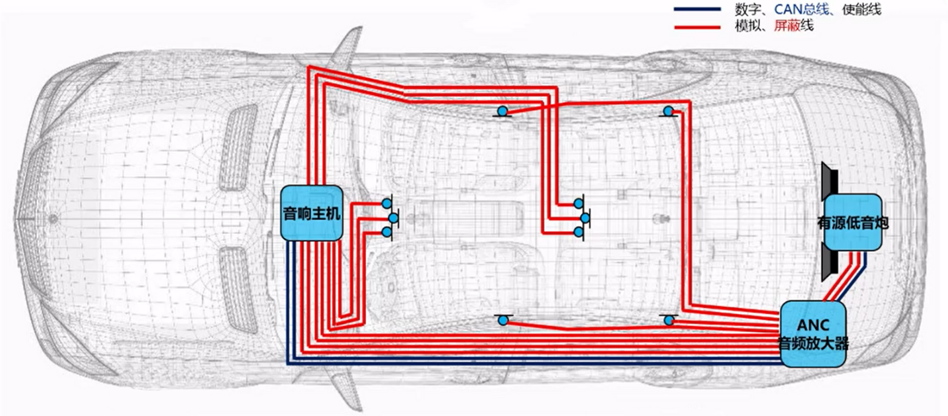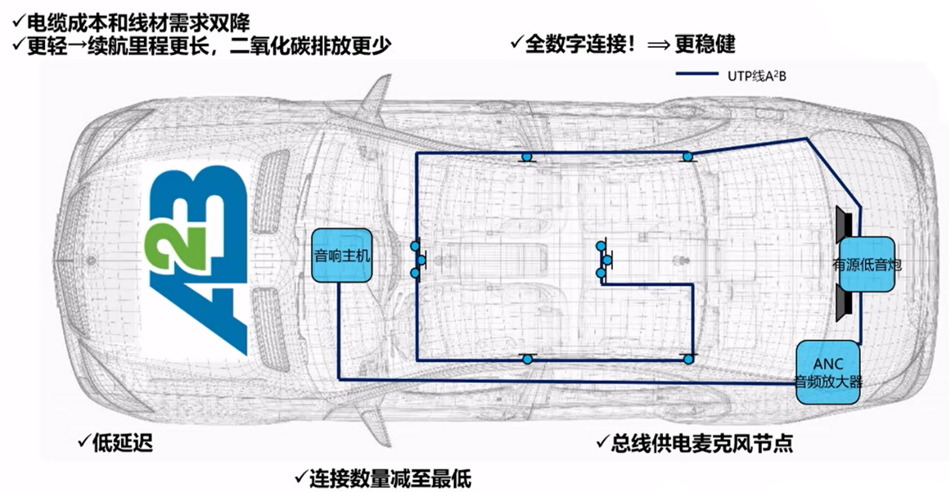1. Introduction
As automobiles adopt new infotainment technologies and advanced driver assistance systems (cameras, microwave radar, LiDAR, etc.), along with various sensors measuring different data (stability, speed, acceleration, etc.), the number of electronic systems within vehicles has increased, and complexity has reached new heights. This places significant demands on communication buses.
The various buses used by many different subsystems involve highly complex (and expensive) cabling. For automotive applications, size and weight present new challenges, as meeting new environmental regulations necessitates developing new systems capable of reducing CO₂ emissions, for example. In this context, meeting the requirements for a high-bandwidth, low-latency, deterministic, robust, and inexpensive communication bus becomes difficult.
Cabling for automotive audio systems contributes significantly to the total cable weight because analog lines require expensive shielded cables running from the audio source to the endpoints (speakers). Furthermore, Active Noise Cancellation (ANC) and Road Noise Cancellation (RNC) systems require the installation of multiple microphones inside the vehicle, adding numerous input nodes to the audio network.

Figure 1 Actual Wiring of Traditional Automotive Audio System
The pressures facing the actual wiring of traditional automotive audio systems are evident:
● Proliferation of microphones and speakers
● Weight reduction to increase MPG (Miles Per Gallon)
● Noise reduction (ANC and RNC)
● Cost control
● Reduced complexity——Improved reliability
To address these issues, ADI (Analog Devices, Inc.) introduced the A²B (Automotive Audio Bus) in-vehicle audio bus.
2. Overview
The A²B (Automotive Audio Bus) is an in-vehicle audio transmission bus protocol developed by ADI (Analog Devices, Inc.), a globally recognized leader in data conversion and signal processing technology.
A²B supports a daisy-chain topology, where a single Master can connect to up to 10 Slaves in series. Optimized for audio applications, A²B operates at 50 Mbps. By utilizing Unshielded Twisted Pair (UTP) cabling, it significantly simplifies connections, reducing the total wiring harness weight by up to 75%. The distance between nodes can reach 15 meters, with a maximum network length of 40 meters. It also supports power delivery over the UTP cable, making it ideal for digital microphones.

Figure 2 A²B Audio Wiring
Due to its numerous advantages—reducing cable cost and weight, supporting bus-powered devices (microphones, speakers, sensors), low latency (<50μs), high determinism (ideal for ANC), and 50 Mbps bidirectional data transfer—A²B has become the preferred choice for many automakers in new vehicle audio architectures. Currently, over 90% of automakers use A²B for developing new vehicle architectures.
Testing of in-vehicle audio equipment has also evolved with the popularity of the A²B bus. Beijing Doewe Technologies Co., Ltd. offers the following two different solutions for testing automotive audio components using the A²B protocol.
3. Test Solutions
3.1 ABTEC's A²B Test Solution
As mentioned earlier, the A²B bus link structure consists of a single Master and up to 10 Slaves. This solution utilizes the A²B Audio Bus Interface Option module on the ABTEC audio analyzer, allowing the analyzer to connect as either the Master or a Slave into the Device Under Test (DUT) link for testing. Different connection methods are shown in the figures below.
The test system mainly includes: Audio Analyzer + A²B Audio Bus Interface Option Module, Artificial Mouth (for microphone testing), Control PC, and the DUT.
Master Connection Testing:

Figure 3 Microphone Array Test Link

Figure 4 Automotive Amplifier Test Link
For microphone testing, the audio analyzer outputs test audio to a calibrated microphone. The microphone captures the audio and sends it back via the MASTER interface on the A²B module to the audio analyzer for analysis.
For amplifier testing, test audio is output via the MASTER interface on the A²B module to the DUT. After processing by the DUT, the signal is input to the audio analyzer for analysis.
Slave Connection Testing:

Figure 5 Slave Connection Test Link
When the audio analyzer is connected as a Slave for testing, it receives signals from the DUT Master via the SLAVE interface on the A²B module for analysis.
Compared to other test methods, the biggest advantage of using this approach for A²B bus testing is that a single instrument can complete link setup and testing, simplifying hardware connection steps and test procedures, while also reducing test costs.
3.2 Traditional A²B Test Solution
Microphone Test Solution:

Figure 6 A²B Microphone Test Connection Diagram
Description: The A²B microphone test system mainly includes: Audio Analyzer, A²B Analyzer, Artificial Mouth, Control PC, and DUT Microphone.
The audio analyzer outputs test audio to a calibrated artificial mouth. The DUT microphone captures the test audio emitted by the artificial mouth and transmits it via an A²B cable to the A²B Analyzer. The control host opens the A²B analysis software and audio analysis software, which interact via ASIO. The control host connects to the A²B Analyzer and the Audio Analyzer via two USB cables respectively, and analyzes the audio signals obtained from the A²B Analyzer.
Speaker Test Solution:

Figure 7 A²B Speaker Test Connection Diagram
Description: The A²B speaker test system mainly includes: Audio Analyzer, A²B Analyzer, Test Microphone, Control PC, and DUT Speaker (including the audio output node).
The control host opens the A²B analysis software and audio analysis software, which interact via ASIO. The control host connects to the A²B Analyzer and the Audio Analyzer via two USB cables respectively. The control host sends test audio to the A²B Analyzer. The A²B Analyzer transmits the test audio via an A²B cable to the in-vehicle audio output node. The node sends the test audio via its analog output interface to the DUT automotive speaker. Finally, the test microphone captures the audio signal and sends it to the audio analyzer for audio analysis and processing.
This test solution requires an additional A²B Analyzer, making hardware connections and test procedures more complex, and the cost is relatively higher.
4. Introduction to Core Test Equipment and Modules
4.1 Core Test Equipment A5

The A5 Audio Analyzer, sold by Beijing Doewe Technologies Co., Ltd., is a professional audio analyzer integrating high performance, multiple interface types, and diverse test functions. It supports a range of test plug-in expansions and various digital audio interfaces (BT/I²S/HDMI/PDM, etc.), making it the preferred test equipment for the R&D stage of consumer audio and automotive electronics products.

4.2 A²B Test Module

The A5-A2B module interface features independent Master and Slave ports, providing direct connection to the DUT. It also includes an additional power input interface for auxiliary testing. This interface, combined with the powerful ATC audio test software, enables closed-loop, multi-channel audio testing of A²B systems and components, such as automotive head units, automotive amplifiers, automotive microphones, and other related consumer products.
Key Features:
(1)Multi-channel audio testing for A2B systems and components
● Supports up to 32 channels of audio stream input and output
(2)Master Characteristics
● Supports up to 10 nodes, with independent access to each node's I2C and GPIO
● Bus power supply capability: 8V@500mA
● Downstream audio stream up to 32 channels, THD+N ≤ -186dB
● Supports sweep testing for connected nodes
(3)Slave Characteristics
● Flexible configuration, can be connected as input or output to the A2B network
● Up to 32 channels of audio output
● Independent Master and Slave ports can be used simultaneously
(4)Supports external power input (DC 12V)